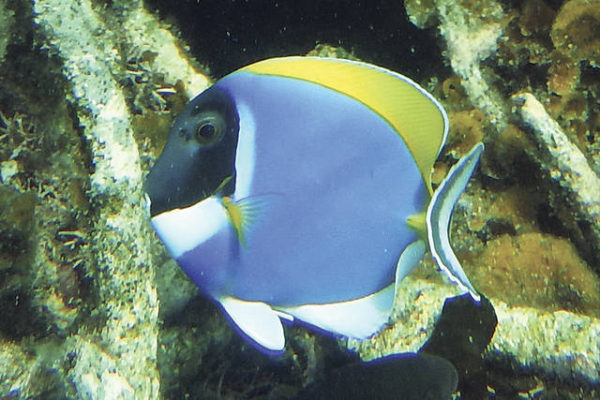Published in the Ocean Watch column, Honolulu Star-Advertiser © Susan Scott
March 16, 2019
While sorting through photos from our recent snorkeling trip in Zanzibar, I came across a dozen terrible pictures of blue tangs. The shots were either blurry or of tails as the shy fish darted into hiding.
Craig and I were trying to get at least one good picture of a blue tang, because they don’t live in Hawaii waters and the species is rare in the places we’ve snorkeled in the South Pacific. But like the acres of anemones in Zanzibar’s waters, blue tangs were abundant, sometimes swimming in schools of 10-20 individuals. Those bright blue bodies with yellow fins delighted us hour after hour.
 A powder blue tang off the southwest coat of Zanzibar.
A powder blue tang off the southwest coat of Zanzibar.
Courtesy Craig Thomas.
Why did I want a picture of a blue tang? This is the species, I thought, that Pixar artists and Ellen DeGeneres made famous as Dory, the lovable fish with short-term memory loss.
I was wrong. When I finally found a halfway decent photo of a blue tang, it turned out to be a different species from Pixar’s Dory. Dory is a royal blue tang, or Paracanthurus hepatus, and the ones we were chasing off Zanzibar were powder blue tangs, Acanthurus leucosternon. Another species common in the Caribbean is also called a blue tang, or Acanthurus coeruleus.
Common names of fish can be confounding because there is no international agreement, such as there is for birds, about what English name to call a species. Latin names are more reliable, but few people know Latin well enough to remember those names.
In any case, the tangs called blue, powder blue and royal blue are relatives that evolution separated into different species. But the fish have more in common than they do in differences.
All are surgeonfish, a family of coral reef fish that eat algae and, therefore, tend to live in shallow water because algae need bright light to thrive. Some surgeonfish in the Caribbean are known as doctor fish, and some surgeonfish are called tangs.
“Tang” is the German word for seaweed. For reasons unknown, people named 13 of the world’s 80 surgeonfish species tangs.
Most surgeonfish have small mouths with teeth efficient at biting algae off rocks and coral heads. These “lawn mower” fish are crucial to healthy reefs because they keep plants from growing over corals, which also need sunlight to thrive.
Surgeonfish may be vegetarians, but you don’t want to get too close. The family name comes from razor-sharp “scalpels,” one on each side just in front of the tail. The fish use their blades for defense only. Cuts to human hands mostly occur when feeding surgeonfish or when removing them from hooks or nets.
OK, so the Dory Craig and I pursued was not actually a Dory. It doesn’t matter. We had a good time Finding Dory’s cousin.